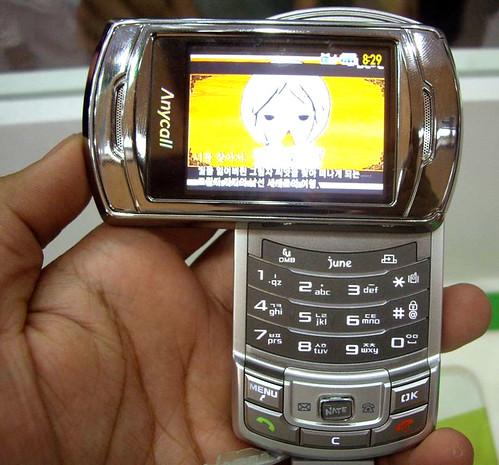Mobile TV Olympics

Bèibei, Jīngjing, Huānhuan, Yíngying, Nīni — the Fuwa, official mascots of the Beijing 2008 Olympiad. Each represents one of the five Chinese elements: Water, Wood, Fire, Earth, Air, respectively. Colored for the five Olympic rings, we can expect a lot of them over the course of this summer, with the Beijing 2008 opening ceremony on Friday, 8 August 2008.
The swirling stories around the 3.5 hour show are getting interesting — from a giant winking panda to fantastic fireworks. According to one of the producers, "The world can expect, of course, to be gobsmacked…"
Imagine a 100-m-wide red flower opening up its petals; picture 10,000 bicycles circling the Olympic stadium and transforming into hi-tech robots; then envisage Peking Opera performers morphing into hip-hop dancers and singing in English.
Finally, picture a 50-m-tall giant inflatable panda, which turns its head and winks at the world.
These powerful images of rapid change and spectacular icons are the possible eye-candy in the Middle Kingdom’s biggest ever ceremony.
China’s record-breaking social and economic changes over the past 20 years will become one of the major themes of the Olympic opening ceremony, according to one of the key members of the team.
Although opening ceremony organizers are sworn to secrecy, Games ceremonies guru Ric Birch has hinted that China’s great changes will be a dominant theme.
"The fact China has achieved so much in one generation is so extraordinary, we can’t compute it," he told China Daily.
"There has never been an equivalent, so we don’t have benchmarks.
"All these issues will come together for me in Beijing for the opening ceremony."
Australian Birch is a key adviser to Zhang Yimou, who wields full creative control over the ceremonies.
I still like Jack Black’s arrival in Cannes last month…

The Olympics are an immense undertaking and China will be under an intense global media spotlight. TV news crews from all over the world will need to coordinate their RF transmit-receive equipment like never before.
What we might expect to see unveiled is which mobile TV standard will be selected as the national standard in China. EE Times did a piece on this a month ago:
"We used to joke that there are as many standards in China as there are universities, but it looks like CMMB is pulling ahead," said Azzedine Boubguira, vice president of business development for DiBcom, which designs demodulators.
DiBcom, Siano and Beijing-based Innofidei Inc. will all have CMMB silicon ready by the end of this year or early next. Innofidei already has a chip out, having released a first-generation demodulator in March, and hopes to have a smaller, lower-power version by October. Around that time, two satellites will be launched in preparation for network trials in the spring and modest commercial services targeted at the Olympics.
At least, that’s the plan. "It will be a rush job for sure. I don’t see it happening by then," said Duncan Clark, managing director of telecom consultancy BDA China. Others are also doubtful, including the chip makers themselves.
It has become increasingly clear that CMMB’s benefactor, the State Administration for Radio, Film and Television (Sarft), is willing to use its power over frequency allocation and content licensing to see that CMMB wins out over competing standards, including established international formats such as Europe’s DVB-H and South Korea’s T-DMB. But the CMMB effort’s estimated $3 billion price tag may not fly with government bean counters. And China’s track record for implementing homegrown technologies is spotty. Its highest-profile case thus far is a 3G technology, TD-SCDMA, whose ascendancy has easily set back the rollout of 3G services for at least a year as engineers rush to make it reliable.
Sarft introduced CMMB last October. The spec is based on a homegrown transport technology known as STiMi (short for "satellite and terrestrial interactive multiservice infrastructure"). The service operates in the 2.6-GHz frequency, using 25 MHz of bandwidth to offer 25 video and 30 radio channels, plus some data channels. STiMi supports the S- and UHF/VHF bands and will use both satellites and terrestrial relays to implement coverage. The technology bears some resemblance to Europe’s DVB-SH (for satellite service to handheld devices).
Competitive and regulatory challenges could impede CMMB’s progress. A chip maker associated with the development of China’s free-to-air transmission standard, DMB-T, is trying to field a low-power chip set for portable media players (PMPs), automotive displays and notebook PCs (via USB dongles). The company, Legend Silicon, believes those uses will trump handsets as the early market for mobile TV in China.
"There’s enough money to be made in USB and PMPs, plus we have the larger market of set-top boxes and TVs," said Hong Dong, a co-founder of Legend.
Interestingly, the USB and PMP market is also the initial target of CMMB backer Innofidei. By sidestepping the handset, at least for now, these companies are waiting to see the outcome of a potential showdown among CMMB, DMB-T and another, little-known standard that has been floated by a rival bureaucracy, the Ministry of Information Industry (MII).
The spec, T-MMB (Terrestrial-Mobile Multimedia Broadcasting), is a T-DMB derivative developed by Beijing software firm Nufrontsoft in conjunction with two local universities. The MII-backed format supports frequencies from 30 MHz to 3 GHz. Like T-DMB, which is based on the Digital Audio Broadcasting spec, it uses bandwidth of 1.536 MHz and can support four to seven video channels and two audio channels.
At the moment, it’s uncertain how committed MII is to backing T-MMB and instigating a turf battle. Insiders said T-MMB seems to have the least support.
The minutiae of bureaucratic maneuvers may have a profound impact on the way the mobile-TV industry develops in China. If CMMB is to be successful, it needs the backing of telecom regular MII, which approves handsets for distribution to operators. On the other hand, if MII wants to push T-MMB, it would have to get Sarft to approve frequencies and content licenses.
"They need each other to be successful, but they need telecom convergence to see this happen. So they are kind of stuck," said BDA’s Clark.

All this uncertainty greatly influenced EchoStars decision (10-Q Statement) to suspend their S-band payload plans:
We are suspending construction of the CMBStar satellite and may record an impairment charge. During April 2008, we notified the State Administration of Radio, Film and Television of China that we were suspending construction of the CMBStar satellite pending, among other things, further analysis relating to efforts to meet the satellite performance criteria and/or confirmation that alternative performance criteria would be acceptable. We are also currently evaluating potential alternative uses for the CMBStar satellite. Therefore, we could be required to record an impairment charge relating to the CMBStar satellite. We currently estimate that this potential charge could be as much as $100 million, which would have a material adverse effect on our results of operations and financial position.
Good of EE Times to pick up on that one, too, and concluding no satellite capacity exists to launch a new national standard in China:
When the Beijing Olympic Games start in August, China’s much-touted mobile TV broadcast service will have to crawl before it can walk–because it’s missing one leg.
The homegrown Chinese system has been designed to operate by picking up two signals: a 2.6-GHz satellite signal and a 700-MHz terrestrial signal. (see: Satellite mobile-TV spec gains influential backers in China)
However, no satellite will be operating in time to realize the full promise of the China Multimedia Mobile Broadcasting (CMMB) standard — technology also known as STiMi (satellite and terrestrial interactive multiservice infrastructure).
EchoStar, the primary provider of S-band satellite capacity for China’s mobile video project, quietly revealed in its 10-Q form filed with the U.S. Securities and Exchange Commission in late May that it is suspending construction of the CMBStar satellite.
China Satellite Mobile Broadcast (CSM), a company overseen by the Wireless Bureau of China’s State Administration of Radio, Film and TV (Sarft), last year selected China Mobile Broadcasting Satellite (CMBSat), a Hong Kong-based affiliate of EchoStar, as its partner.
EchoStar claimed that it already notified the Sarft of its intentions in April. But the U.S. firm has not explained why it suspended activities in China, other than saying that its decision is "pending, among other things, further analysis relating to efforts to meet the satellite performance criteria and/or confirmation that alternative performance criteria would be acceptable."
It remains unclear if any technical problems have surfaced, or if the delay is purely a negotiating ploy by EchoStar or CSM.
Although EchoStar remains a viable candidate to deliver a satellite to China, a growing likelihood is that China will turn to its own satellite companies to launch a satellite in the first quarter of 2009.